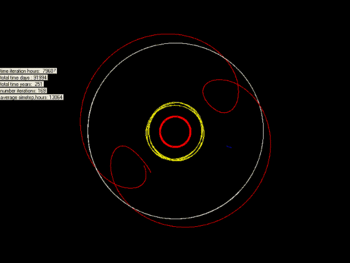 Orbital diagram (top view) Orbital diagram (top view) | |
| Discovery | |
|---|---|
| Discovered by | NEAT |
| Discovery site | Palomar |
| Discovery date | 8 April 2002 |
| Designations | |
| MPC designation | (55576) Amycus |
| Pronunciation | /ˈæmɪkəs/ |
| Named after | Amycus |
| Alternative designations | 2002 GB10 |
| Minor planet category | Centaur |
| Adjectives | Amycian /əˈmɪsiən/ |
| Symbol | |
| Orbital characteristics | |
| Epoch 13 January 2016 (JD 2457400.5) | |
| Uncertainty parameter 2 | |
| Observation arc | 7204 days (19.72 yr) |
| Aphelion | 35.019 AU (5.2388 Tm) (Q) |
| Perihelion | 15.178 AU (2.2706 Tm) (q) |
| Semi-major axis | 25.098 AU (3.7546 Tm) (a) |
| Eccentricity | 0.39526 (e) |
| Orbital period (sidereal) | 125.74 yr (45926.7 d) |
| Mean anomaly | 37.041° (M) |
| Mean motion | 0° 0 28.219 / day (n) |
| Inclination | 13.352° (i) |
| Longitude of ascending node | 315.45° (Ω) |
| Argument of perihelion | 239.17° (ω) |
| Jupiter MOID | 9.92261 AU (1.484401 Tm) |
| TJupiter | 4.133 |
| Physical characteristics | |
| Dimensions | 76.3±12.5 km |
| Synodic rotation period | 9.76 h (0.407 d) |
| Geometric albedo | ~ 0.18 |
| Spectral type | |
| Apparent magnitude | ~ 20 |
| Absolute magnitude (H) | 7.8 |
55576 Amycus /ˈæmɪkəs/ is a centaur discovered on 8 April 2002 by the NEAT at Palomar.
The minor planet was named for Amycus, a male centaur in Greek mythology.
It came to perihelion in February 2003. Data from the Spitzer Space Telescope gave a diameter of 76.3±12.5 km.
A low probability asteroid occultation of star UCAC2 17967364 with an apparent magnitude of +13.8 was possible on 11 February 2009. Another such event involving a star with an apparent magnitude of +12.9 occurred on 10 April 2014 at about 10:46 Universal Time, visible for observers in the southwest US and western Mexico.
Near 3:4 resonance of Uranus
Amycus (2002 GB10) lies within 0.009 AU of the 3:4 resonance of Uranus and is estimated to have a long orbital half-life of about 11.1 Myr.

See also
References
- ^ "JPL Small-Body Database Browser: 55576 Amycus (2002 GB10)" (2007-08-15 last obs). Retrieved 12 April 2016.
- Noah Webster (1884) A Practical Dictionary of the English Language
- Marc W. Buie. "Orbit Fit and Astrometric record for 55576" (2003-06-22 using 73 of 81 observations). SwRI (Space Science Department). Archived from the original on 4 June 2011. Retrieved 28 February 2009.
- ^ John Stansberry; Will Grundy; Mike Brown; Dale Cruikshank; John Spencer; David Trilling; Jean-Luc Margot (20 February 2007). "Physical Properties of Kuiper Belt and Centaur Objects: Constraints from Spitzer Space Telescope". arXiv:astro-ph/0702538.
- ^ Wm. Robert Johnston (22 August 2008). "List of Known Trans-Neptunian Objects". Johnston's Archive. Archived from the original on 13 February 2009. Retrieved 28 February 2009.
- ^ Hainaut, O. R.; Boehnhardt, H.; Protopapa, S. (October 2012). "Colours of minor bodies in the outer solar system. II. A statistical analysis revisited". Astronomy and Astrophysics. 546: 20. arXiv:1209.1896. Bibcode:2012A&A...546A.115H. doi:10.1051/0004-6361/201219566. S2CID 54776793. Retrieved 26 September 2019.
- "AstDys (55576) Amycus Ephemerides". Department of Mathematics, University of Pisa, Italy. Archived from the original on 26 May 2011. Retrieved 15 March 2009.
- Steve Preston (8 January 2009). "Star occultation by asteroid 55576 Amycus". IOTA (International Occultation Timing Association). Retrieved 28 December 2009.
- Hans-J. Bode; Filipe Braga Ribas; B. Sicardy (2013). "Bright Star Occultations by TNOs in 2014. J. Occultation Astronomy 2014-1". IOTA (International Occultation Timing Association).
{{cite journal}}: Cite journal requires|journal=(help) - Horner, J.; Evans, N.W.; Bailey, M. E. (2004). "Simulations of the Population of Centaurs I: The Bulk Statistics". Monthly Notices of the Royal Astronomical Society. 354 (3): 798–810. arXiv:astro-ph/0407400. Bibcode:2004MNRAS.354..798H. doi:10.1111/j.1365-2966.2004.08240.x. S2CID 16002759.
- Showalter, Mark R.; Benecchi, Susan D.; Buie, Marc W.; Grundy, William M.; Keane, James T.; Lisse, Carey M.; Olkin, Cathy B.; Porter, Simon B.; Robbins, Stuart J.; Singer, Kelsi N.; Verbiscer, Anne J.; Weaver, Harold A.; Zangari, Amanda M.; Hamilton, Douglas P.; Kaufmann, David E. (2021). "A statistical review of light curves and the prevalence of contact binaries in the Kuiper Belt". Icarus. 356: 114098. arXiv:2105.03543. Bibcode:2021Icar..35614098S. doi:10.1016/j.icarus.2020.114098. S2CID 225284888.
External links
| Minor planets navigator | |
|---|---|
| Small Solar System bodies | |||||||
|---|---|---|---|---|---|---|---|
| Minor planets |
| ||||||
| Comets | |||||||
| Other | |||||||